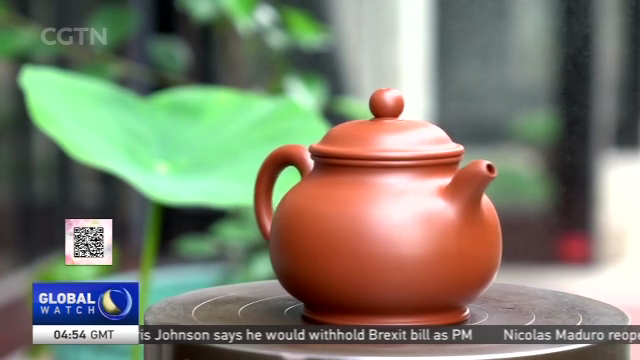
13:14, 09-Jun-2019
Passing Down Traditions: Promoting handmade teapot craftsmanship
Updated
00:01, 10-Jun-2019
02:24

Chinese people have been drinking tea for thousands of years. But in more recent times, these handmade teapots are gaining in popularity. As an old saying goes, a thing is valued if it is rare.
WU LEI HANGZHOU "Tea sets have been a key part of Chinese dietary culture. And this kind of handmade purple clay teapot is one of the most popular items among tea lovers. But this craftsmanship is at risk of disappearing."
99-year-old Gao Dezhi has been making purple clay teapots since he was 13. This kind of skill is usually passed down among generations or taught to those who are passionate about the craft. But Gao says it is now very difficult to find such people.
GAO DEZHI PURPLE CLAY TEAPOT MASTER "My son and daughter are not interested in learning how to make teapots. They already earn a lot of money working in the finance sector. People cannot create such things if they have no interest in acquiring the skill."
In order to promote and protect skills at risk of disappearing, local authorities have built a special museum where masters can showcase their craftsmanship.
While in Yixing, Jiangsu province, the birthplace of the purple clay teapot, 29-year-old Wu Zhiqiang has lured many fans to his store via the internet. It's here that they learn how to make the purple clay teapot.
WU ZHIQIANG PURPLE CLAY TEAPOT MASTER "I always post some pictures, descriptions and videos on the internet, sharing my knowledge and expertise with others. At the same time, I often invite my followers to my store to get first-hand experience."
With thousands of followers at various online platforms, Wu Zhiqiang feels today many young customers prefer new teapot patterns and shapes.
WU ZHIQIANG PURPLE CLAY TEAPOT MASTER "For example, Peppa Pig is very popular right now, I saw someone carved Peppa on the teapot. Younger customers like more customized teapots with modern elements."
There are thousands of private stores featuring this kind of teapot in Yixing city. Wu says he's not worried about this traditional skill disappearing. He feels the key is to cultivate young people's interests in the art in modern and customized ways.

SITEMAP
Copyright © 2018 CGTN. Beijing ICP prepared NO.16065310-3
Copyright © 2018 CGTN. Beijing ICP prepared NO.16065310-3